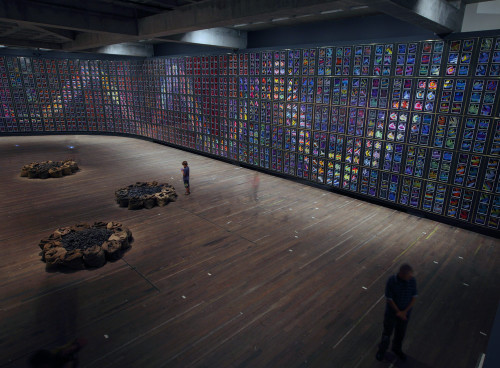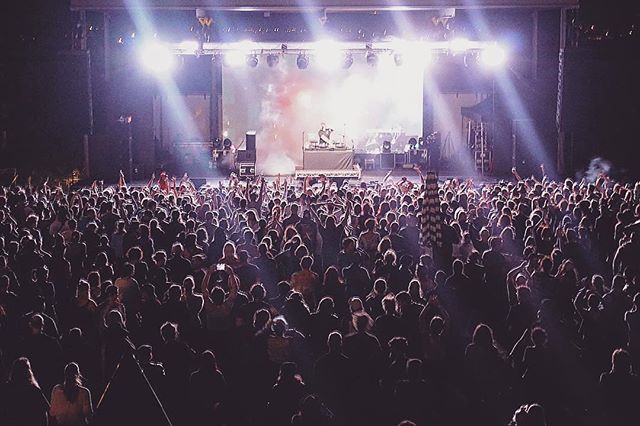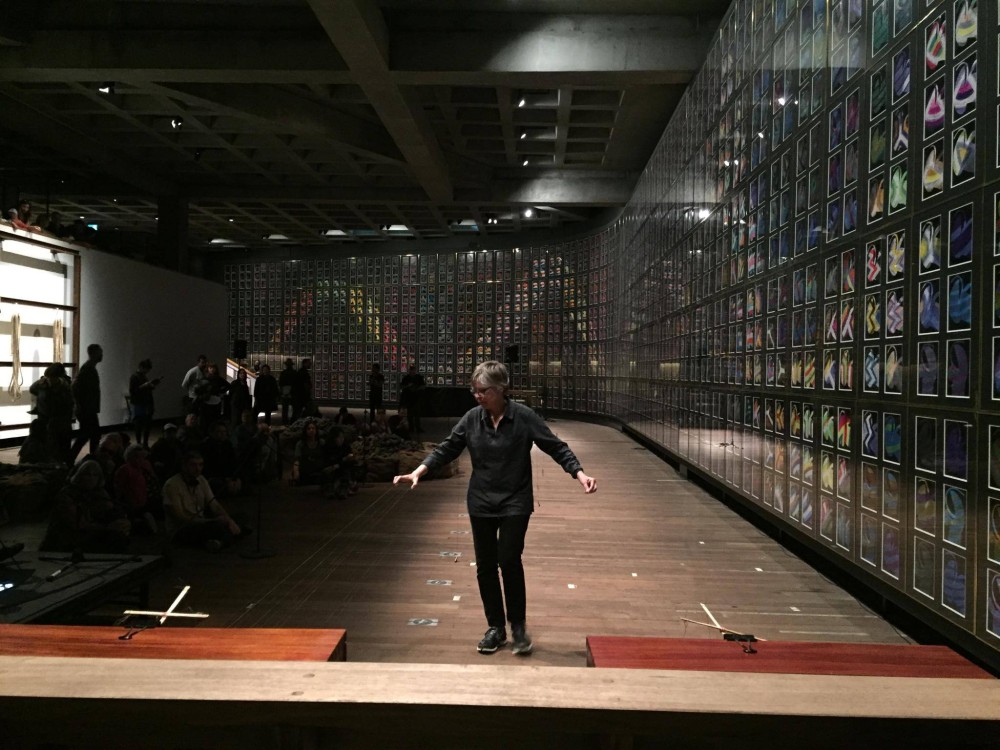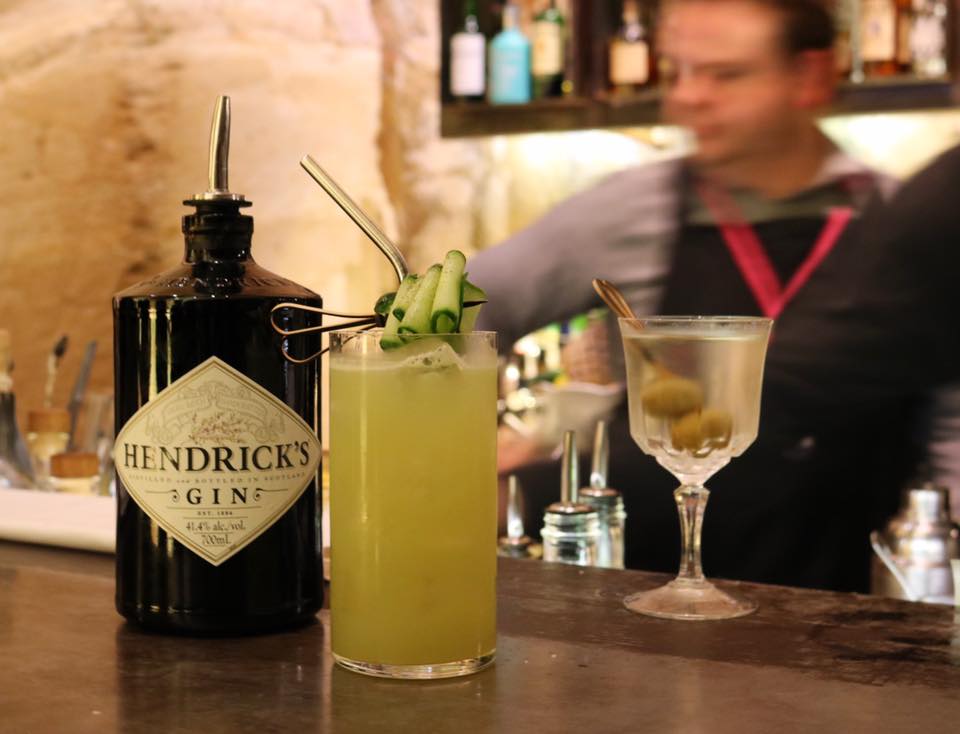Festival season is wrapping up soon in Australia, and after a few months of late nights, muddy boots and long, hot afternoons, we often find ourselves asking exactly what makes a festival stand out, which was best, which one we might me revisit the following year. This question was burning particularly bright in my mind this year after I visited both Falls Festival Marion Bay and MONA FOMA, which couldn’t have been more different. One caters to the masses, focuses on popular music and the DIY camping experience, while the other is small, weird and focused on art and music equally. Comparing the two is pointless as they offer entirely different experiences. Falls successfully captures the big festival experience, while MONA FOMA crafts something so distinct and unusual that you have to admit it’s not for everyone – but it certainly is for us.
2017 was set up to be a big year for the summer leg of the Tasmanian festival, with the lineup featuring the world premiere of Tetema, a project from Mike Patton and Anthony Pateras – which had previously only been recorded, never performed live – Maynard James Keenan‘s Puscifer, Kaitlyn Aurelia Smith, Circuit Des Yeux and more. Sitting alongside the music is, of course, the stunning Museum of Old and New Art (MONA) itself. A maze-like underground complex that serves as an open collection of David Walsh’s weird and wonderful art and artefacts, the museum is as much an attraction as the music. And then there were the grounds of the museum, where the stages and markets were mere foreground for the breathtaking views of the Derwent River. It all came together to form a weekend that was indefinably special.
Music
The Little Guys
Mona has become famous for its impeccably obscure curation and 2017 was no different. From the big headliners to local names, you can guarantee that even the names you’re unfamiliar with will offer something magnetic and unique. Discovering new music like this is something we’re particularly fond of, and Mona Foma offered it in droves. The lineup ranged from experimental dream-pop singer Rainbow Chan to Mdou Moctar, a Niger-based electronic artist who made a biopic based on Purple Rain. Diversity was the name of the game.
So when I trudged up the hill towards the museum on the dreary Friday, my mood was at direct odds with the weather. Checking the timetable, I set a path towards the Nolan Gallery to see Rainbow Chan. The gallery is a gigantic hall specifically designed to hold Sidney Nolan’s Snake. Two keyboards were set up in the corner of the room, dwarfed by the massive artwork. When Rainbow Chan herself appeared, she immediately set about staking her claim on the room, launching into a delightfully energetic set. She looped vocals and keys into each other to create a weaving dream-pop beat before dancing and singing her way into the audiences attention. By the end of her set, all thoughts of the rubbish weather outside was forgotten, replaced by excitement for what the weekend would bring.
The next standout performance was Moses Sumney, an artist we absolutely adore. Coming on stage to a minimal set up with three mics and a looping machine, Sumney stunned the crowd with his tremendous ability to create some truly beautiful songs from simple clapping, clicking and vocal loops. He played a fair amount of fan favourites such as Worth It and Everlasting Sigh, as well as offering a small preview into his upcoming album. The mood of the set was playful despite the touching music, and Sumney seemed to be having fun with the crowd.
In contrast to this was Circuit Des Yeux, who played a wonderfully haunting set. Coming to the stage wielding a 12-string guitar, she launched into some of her best songs. The highlight of the set was either her opening of Do The Dishes, a song I find to perfectly encapsulate all I love about Circuit Des Yeux, or the climax of A Story Of This World. The latter came towards the tail end of her set, and it benefitted from the crowd becoming enthralled in the music that was being spun. Circuit Des Yeux’s incredible deftness with her 12-string was beyond impressive, and its combination with her deep and haunting calls made the performance truly remarkable.
Headliners
At some festivals, the bigger acts can be less inviting than the smaller ones, due to the overflowing stages and the need to please as many attendees as possible. Not so for Mona Foma, whose main stage is probably smaller than even the tiniest Falls or Splendour stage. As for pleasing everyone, well, this is the kind of festival where attendees trek to Hobart because they like weird stuff. The sheer musical diversity of the main headline acts was incredible, but it worked.
Headlining the Friday night was Puscifer, probably the least famous of Maynard James Keenan’s projects, after Tool and A Perfect Circle. Of course a few card-carrying Tool Army members showed up, and though the set was strictly Puscifer, they were hopefully left impressed regardless. The stage show was ridiculous, seriously, one of the weirdest and best stages I’ve ever seen. The band were in fine form, including sublime co-fronting duties from Carina Round and a weird spiky mask adorned by MJK, the entire stage was set around a wrestling ring, complete with two male and two female performers who staged violent fights and dramatic scenes throughout the whole set. The set was delivered with vigour, hilarity and intensity – there couldn’t have been a better way to cap off day 1.
Probably the biggest drawcard of the whole festival was Mike Patton and Anthony Pateras’ world premiere of tetema the following day. It’s interesting to note that Mona managed to pull these two huge acts, but did so in the most left-field ways possible. The crowd was littered with Faith No More, Mr Bungle and Fantomas T-shirts, but this is one of Patton’s most obscure, indigestible projects to date. Watch this cacophony of noise and sound on stage was invigorating and brilliant, made all the more exciting because it was the first – and probably only – time it had ever been performed live.
Directly after tetema came something completely different: DJ Z-Trip. One of the world’s foremost hip-hop DJs, a turntablism legend and notorious inventor of the mash-up, Z-Trip delivered something for everyone, in a roaring two-hour set that easily pulled the biggest audience of the weekend, and left them sweaty, hyped, and wanting more. There aren’t many DJs who can not only follow Mike Patton, but do so by mixing everything from Outkast to Tool, Pink Floyd to NWA, Faith No More to The Weeknd and so on. You could tell that he was really playing to the crowd, undoubtedly mixing in more rock and metal than he would at, say, a nightclub, considering the overall vibe of the festival. All in all it was a brave move to put an extreme, experimental group ahead of a DJ, but both worked amazingly well.
Faux Mo
It’s hard to pin down what Faux Mo actually is. If you read the little information booklet that MOFO gives out to explain the various aspects of the festival, you might think that Faux Mo is simply a nightclub. But as I walked through the doors of the old convict-built former government-office building that had been transformed into the venue for the club, it became clear that it was so much more than it was described as. It was more a micro-museum, where every wall was either covered in a painting or a mirror. The space could barely be recognised as a former office building, with concrete floors and broken plaster walls defining the decor more than cubicles and florescent lights. Speaking of the lights… well I’m unsure if I’ve ever seen a better use of the contrast between light and darkness in a club setting before. Every light was placed with precise care and consideration for its surroundings. It all came together to create this tremendous atmosphere of being out of your depth. Large parts of the building were straight-up hidden from those who didn’t look hard enough for openings in dimly lit walls. One particular room was only accessible through a waist-high crawlspace on the edges of a larger main room. The care put into the construction and layout of the building was beyond belief, with each room being a new and separate entity from the last. There were four or five stages scattered around the club, and yet they never intruded sonically into each other (an impressive feat for such a densely packed area). The large main stage area could have Regurgitator (who were fantastic – they played a regular set rather than Velvet Underground stuff) thrashing their hearts out, and the local DJ on the next stage over would hear next to none of it. The real highlight of the night, however, had to be Black Cracker, the Berlin-based dark hip-hop artist who absolutely destroyed. If that makes you think of Death Grips, you’re kind of right. With themes closer to Peaches (who also performed at MOFO) and a sound similar to but much more stripped back than Death Grips, he was a perfect fit for the kind of place that Faux Mo was: Dark, sexy and really, really fun.
MONA as an outsider
One of the main reasons people go to Mona Foma (or to Hobart in general) is to see the museum itself. MONA is unlike anything else you have ever seen in your life, guaranteed. The museum – both the temporary and permanent exhibitions – are arranged with simultaneously impeccable and baffling curation, from ancient Egyptian sarcophagi to a “fat” Porsche, from renaissance-era paintings to pornographic photography and everything in between. Trying to describe this museum would be doing it an injustice; I couldn’t recommend visiting it enough.
The museum itself is this labyrinthine, multi-level underground lair that seems intentionally designed to confuse you and get lost. Also, there’s a bar, and performance spaces, meaning that you got to hear weird and wonderful live music as you walked around. More than once, I ended up back where I started, or stumbling upon a completely new room that, despite wandering around for two straight days, I had not yet seen. The technology was amazing, too – where most museums have signs next to each exhibit, or complex maps accompanied by hefty brochures, MONA utilises “O” technology. It is incredible. On entry you’re handed an iPhone and headphones, and you can then walk off in any direction you like. Hold the phone up in any given room, press the big “O”, it identifies which artworks are near you and brings up information and images related to the item. More info about the tech can be found here – I truly hope more museums adopt this in the future.
MONA & Mona Foma as a Hobart resident
We at Howl & Echoes have talked at length about the Tasmanian music scene, which suffers from the classic small-town problem that it’s hard to get the attention of big name artists. While I’m not going to recap everything we’ve already written on the subject, one thing must be made clear: MONA has nearly single-handedly turned the perception of Tasmania as a cultural entity around. As a young person living in Tasmania, I would often hear my friends bemoan the lack of things to do or see in the years prior to MONA’s opening. Indeed, it was extremely rare to see international bands make a tour stop in Hobart. When MONA arrived, it was received with mixed receptions. More “traditional” residents (Many Tasmanians fiercely resist anything modern or “big city”) regarded the building as a sign of the state succumbing to the sins of the avant-garde. There was a great outcry surrounding the weirder elements of the museum, such as the machine that functions as a mechanised digestion tract. But those with foresight could see that MONA would have a definite effect on the state. It was the beginning of a cultural revitalisation within the state. The early years were somewhat quiet, until the arrival of MONA FOMA (of MOFO for short). The original MOFO (2009) was held in an old warehouse on the waterfront, and was headlined by Nick Cave and The Bad Seeds. Since then, the festival has only grown, undergoing changes in venue and tone over the years. The addition of a winter festival, Dark MOFO, has added another event to the Tasmanian calendar. I was surprised to learn that Dark MOFO has grown to become the more famous of the two festivals (on the mainland at least), but I guess it makes sense. Tasmania has long been seen as a very cold state, and while former tourist ventures have tried to play up the summer activities, MONA’s embracing of what is seen as “Tasmanian” has led to the formation of a unique cultural identity (Quick side note: One writer from the Sydney Morning Herald once said of Dark MOFO “There is no way this event would happen in Sydney). The ritualistic and pagan-esque atmosphere of MONA and MOFO (Dark MOFO in particular) have given all residents something to connect them to the state. No longer to young Tasmanians have to feel ashamed or disappointed in their state; they now have something that is both exciting and uniquely “Tasmanian.”
Mona Foma is without doubt, one of Australia’s most precious gems. The perfect home for those into the weirder sides of art and music, for those who are a little over the hectic #Festivallife of the more mainstream festivals, or if you’re simply after something different, weird, immersive, and phenomenally fun. Surrounded by the beautiful city of Hobart, including the Derwent River and stunning views of Mt Wellington, plied with incredible food and even more delicious wine and cocktails, and generally a unique, open, weird and wonderful atmosphere, I’ve never been to anything like Mona Foma. And I can’t wait to go again.
Co-written by Alex Crellin and Lauren Ziegler




